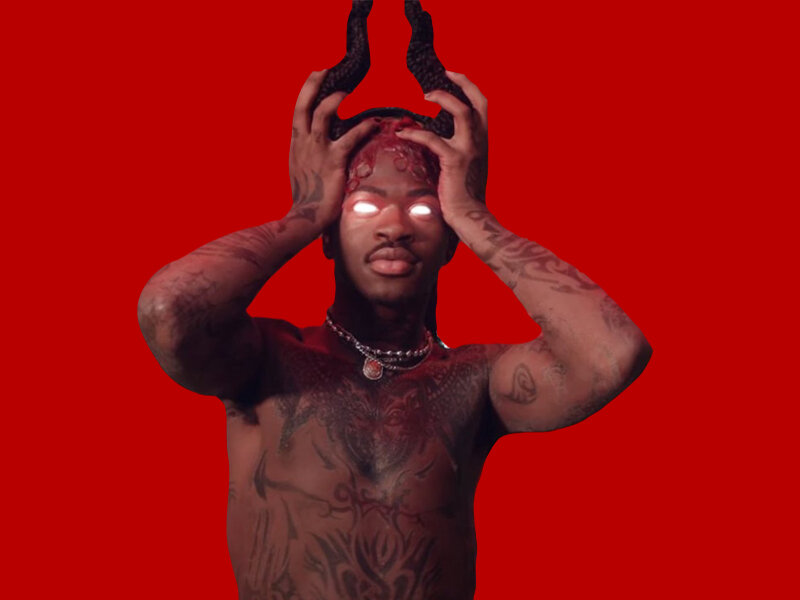Image courtesy of Flickr
By Mariam Keita ’24 & Rose Cohen ’22
Arts & Entertainment Editors
Ever since the openly gay Grammy-winning singer-songwriter Montero Lamar Hill, better known as Lil Nas X, released the official music video for his hit single “MONTERO (Call Me By Your Name),” everything from accusations of plagiarism to legal troubles has followed in his wake.
Inside Eden
The three-minute video opens with a voiceover from the singer, who tells us that we are in Montero, a fictional place where we do not have to banish the parts of ourselves that we do not want the world to see.
He sits alone under a tree, sporting long brown hair and wearing earth tones as he strums a sparkly pink guitar. The scene appears to place a steamy, modern twist on the biblical human origin story of Adam and Eve. Notably, no “Eve” figure accompanies Lil Nas X. However, as he sings the opening lines of the tune, a distinctly phallic snake-like figure with whom he shares a face slithers down the tree just out of sight.
Unlike the biblical Eve, who engages with the serpent in her story, the “MONTERO” singer takes off in the opposite direction, abandoning his instrument, after locking eyes with the snake. As he runs, he is unable to escape the snake-like figure, who shapeshifts into a fluffy pink cloud, then a blossoming flower and finally a tree. Eventually, the snake figure emerges from the grass and overcomes him. The two share a moment of intense eye contact before falling to the ground and locking lips. The singer, not the snake, initiates the kiss.
On his website, the singer explains where the inspiration for “MONTERO” comes from in an open letter to his younger self: “dear 14-year-old montero, i wrote a song with our name in it. it’s about a guy i met last summer. i know we promised to never come out publicly, i know we promised to never be ‘that’ type of gay person, i know we promised to die with the secret, but this will open doors for many other queer people to simply exist.”
These words provide viewers with a framework for evaluating the rest of the video. In the Bible, the snake represents temptation and sinful desire, convincing Adam and Eve to eat from the tree of forbidden fruit. In the music video, the snake seems to act as a proxy for the singer’s sexuality. Additionally, Lil Nas X appears to have condensed Adam and Eve’s roles into one singular, gender-nonconforming figure.
The Trial
In the next scene, we see the singer, now clad in pink, being led into the middle of a colosseum by two guards, both of whom which are different renditions of him, dressed in blue.
Once there, we watch him be shackled and placed on trial before a panel of blue-clad judges (also him). This color-coded dichotomy between the many figures of Lil Nas X, who act as the prosecution, and the lone version, who acts as the defense, should not be overlooked. The blue figures might be a symbol for the performance of masculinity, placing the sole pink figure on trial for failed gender performance. In addition to the judges, hundreds of sculpted onlookers, all bearing his face, watch from the stands. One of the judges wags a finger at him to indicate guilt before the crowd of angry spectators stones him to death — very tongue-in-cheek, considering the spectators are also made of stone. Lil Nas X has played the judge, jury, executioner and the accused.
The following scene appears to show Lil Nas X’s soul ascending to the heavens. As his non-corporeal form floats up above, a winged shadow figure whose face cannot be made out flies just above him. This is the first time in the video that viewers are introduced to a character whom we cannot immediately identify as Lil Nas X. Is the figure an angel or a devil? Is it Lil Nas X again? Could it be God himself? We never find out because Lil Nas X never reaches the paradisiacal realm.
Among the Flames
Before Lil Nas X can complete his ascension to the heavens, a pole shoots up from below and slides into his right hand. Suddenly, he undergoes yet another transformation, sporting thigh-high stiletto heels and artfully gliding down the pole. His hair is now in bright red waist-length braids. The lower he travels, the stronger the glow of red lights becomes. Eventually, it becomes clear that the singer has entered hell.
Rather than falling or stumbling into the inferno, he makes a grand entrance via dance pole. This part of the video bears a strong resemblance to a scene from FKA twigs’ music video for the song “cellophane.” After the English singer contacted Lil Nas X to point out the similarities between their projects, the artist acknowledged that his creative team had taken inspiration from her work. The two even had the same choreographer for each video.
Without an escort, we then see Lil Nas X strut his way into Satan’s palatial den. He seems to know exactly where he needs to go. We never see him knock, nor does anyone greet him along his journey. Despite this, the palace doors seamlessly open and close for him as if someone, perhaps the devil, is expecting his arrival.
He whispers into the ear of the devil himself before climbing onto his lap for a dance. Eventually, standing behind the throne, he trails one hand down the devil’s chest before violently snapping his neck and seizing his crown. The instant the crown touches his head, a large pair of black wings unfurl from his back, identical to those that had appeared on the shadow figure earlier. Having reached his final form and embraced his sexuality, Lil Nas X usurps his greatest enemy and takes over as the king of hell.

